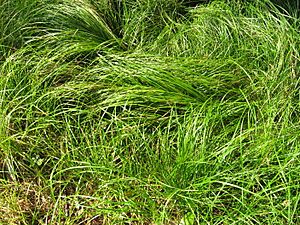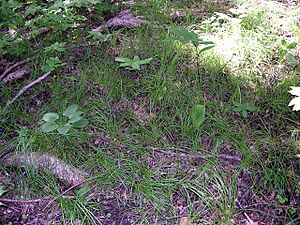Pennsylvania sedge facts for kids
Quick facts for kids Pennsylvania sedge |
|
|---|---|
 |
|
| Conservation status | |
| Scientific classification | |
| Genus: |
Carex
|
| Species: |
pensylvanica
|
| Synonyms | |
|
|
Carex pensylvanica is a type of flowering plant. It belongs to the sedge family, which are plants that look a lot like grasses. People often call it Pennsylvania sedge or sometimes just Penn sedge. Other common names for this plant include early sedge, common oak sedge, and yellow sedge.
Where It Grows
This plant grows naturally in North America. You can find it in eastern Canada, especially in Manitoba, Ontario, and Quebec. In the United States, it is very common in many eastern states. This includes Connecticut, Illinois, Massachusetts, Michigan, Minnesota, New Hampshire, New Jersey, Pennsylvania, Rhode Island, Virginia, and Wisconsin.
It also grows in northern Alabama, the western Carolinas, and parts of Dakotas. You can find it in Delaware, northern Georgia, western Iowa, and northern Indiana. It is also present in northern and eastern Missouri, central and eastern Ohio, and central Tennessee. Other states where it grows are Arkansas, Kentucky, Maine, Maryland, District of Columbia, New York, West Virginia, and Vermont. It has even been seen in one county in Mississippi.
What It Looks Like
Pennsylvania sedge has long leaves that can grow up to 2 ft (0.6 m) (about 60 cm) long. These leaves are narrow, usually about 1 to 3 mm (0.04 to 0.12 in) wide. When they are fully grown, they often arch or bend outwards. The plant also has stems, called culms, which are about 10 to 45 cm (4 to 18 in) long.
This sedge blooms early in the spring, usually from April to June. Each plant produces flower clusters. Each cluster has one thin male spike, which is about 10 to 25 mm (0.39 to 0.98 in) long. Below this, there are one to three shorter female spikes. Each female spike has about 4 to 12 small flowers, called florets.
When the plant blooms, the male spike produces slender, cream-colored parts called anthers. These anthers turn light brown as they get older. Each female floret has three long, white, thread-like parts called styles. The small leaf-like parts under the florets are dark purple.
How It Grows and Spreads
This plant is very good at competing with other plants. It often grows in large areas where it's the only type of plant. It mostly spreads by growing new plants from its roots. It uses cord-like underground stems called rhizomes to spread.
Shorter rhizomes help the plant form small groups, clumps, and mats. Longer rhizomes help it create wide, matted colonies. This allows it to cover a large area.
See also
 In Spanish: Carex pensylvanica para niños
In Spanish: Carex pensylvanica para niños



